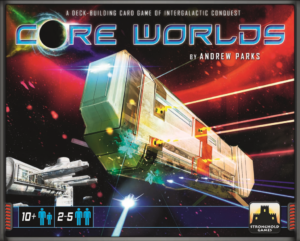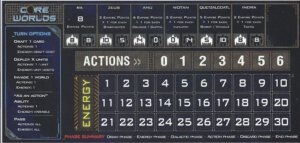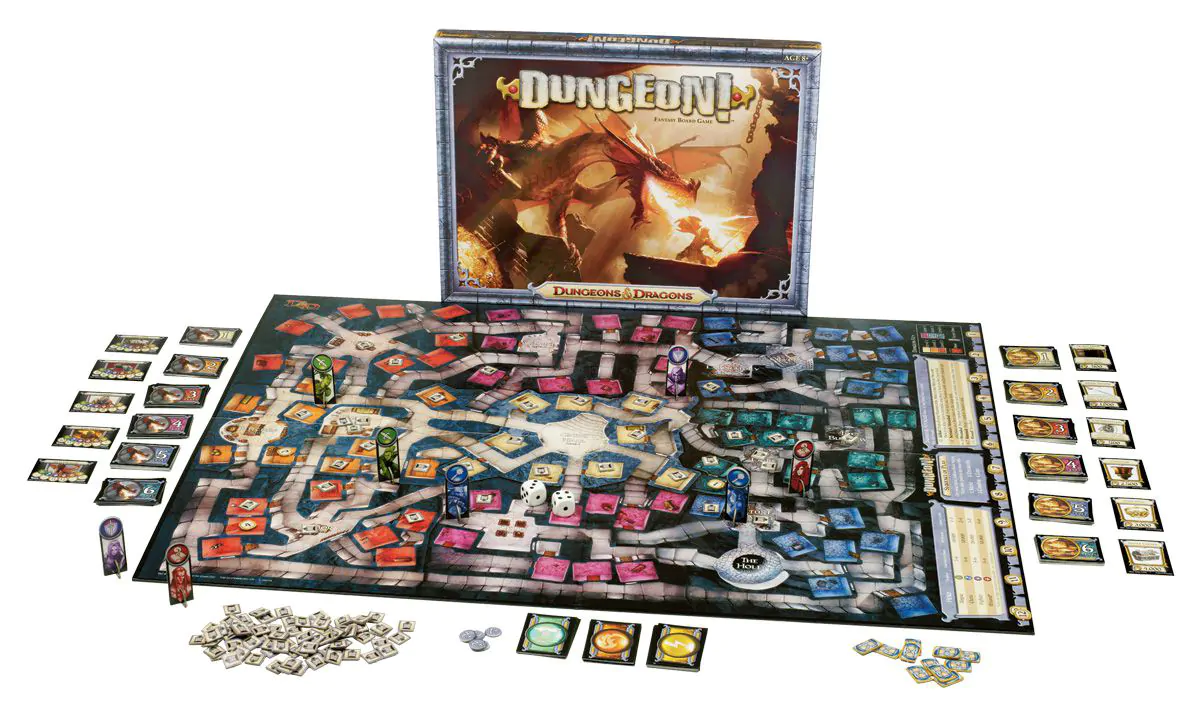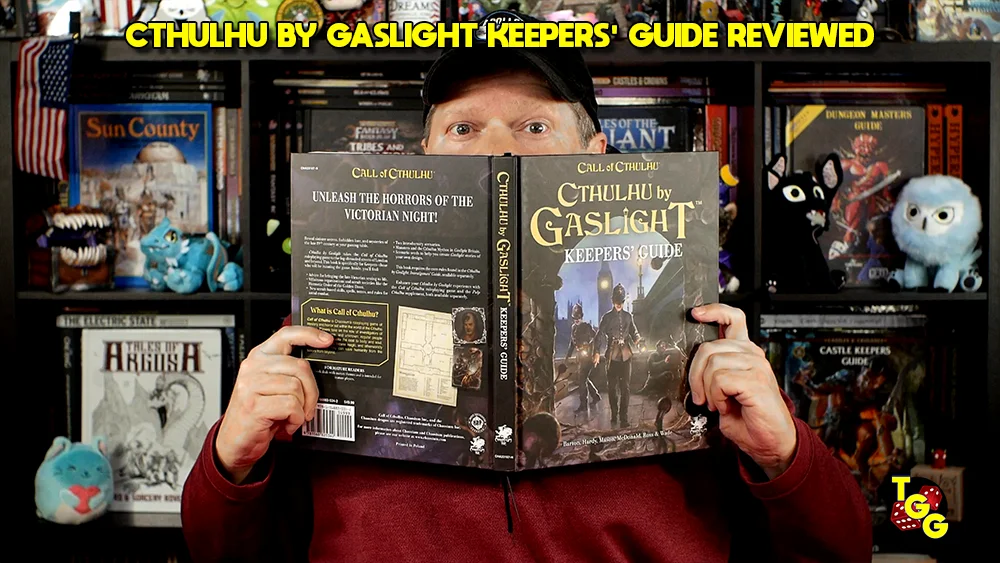Publisher: Stronghold Games
Designer: Andrew Parks
Year: 2011
Players: 2 – 5
Ages: 10+
Playing Time: 90 Minutes
Retail Price: $44.95
Category: Sci-Fi Deck Building Game
Components:
- 1 Round Marker
- 1 Destiny Marker
- 5 Player Boards
- 5 Action Markers
- 5 Energy Markers
- 12 Energy Tokens
- 3 Energy Surge Tokens
- 210 Cards
From Stronghold Games:
The ancient Galactic Realm, ruled from the Core Worlds of the galaxy, is waning. Now, the barbaric kingdoms that lie beyond the galactic frontier are amassing their strength, choosing this pivotal moment to strike at the heart of the fading republic, establishing new empires built upon the ashes of decaying civilizations. But these outer systems are not yet strong enough to engage the forces of the Core Worlds directly. The young kingdoms must first gnaw at the edges of the crumbling frontier, developing new types of units and shrewder tactics. They must build up their energy resources to launch magnificent fleets and overwhelming ground forces. Then, when the time is right, they must strike at the galactic core itself, claiming the most exalted planets for themselves. The barbarian kingdom that achieves these goals will carve out the greatest empire in the galaxy… and rule the Core Worlds.
Each player controls a barbarian Star Empire represented by many cards. Throughout the game, players will invade Worlds and draft new Units and Tactics into their Empires. Each card lists its Empire Points in the upper right corner. The player whose Empire contains the most Empire Points at the end of the game is the winner!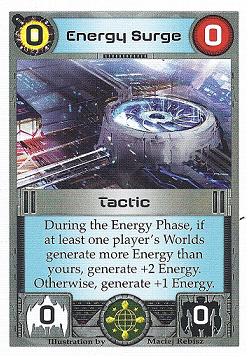
Core Worlds from Stronghold Games is a deck building game of galactic conquest. Your goal is to amass as many Empire Points as you can before the game ends at the completion of the tenth round of play.
The components and cards for Core Worlds are all of high quality with some great artwork. The rulebook is well done, although I did find myself referring to it a lot during the first few plays. This was due mostly to my unfamiliarity with the cards, as there are a bunch of types and icons to remember, but this faded as I got in a few plays so it isn’t a big deal.
Set-up of the game does take a bit of time. Stronghold was kind enough to supply enough bags so that I could separate out the various decks when I was done playing, and this makes it easier. If they come out with some expansion though, it would be nice to have a box all laid out with spaces for the various card types, ala Thunderstone and Dominion.
Each player has their own starting deck of 16 cards, which have different hero cards depending upon the faction you get. You get your faction based on the symbol on the home world that is assigned to you randomly at the beginning of the game. I like the fact that the decks have subtle differences, it adds a bit of uniqueness to each player.
Your home world is placed in your personal War Zone, the section of the table in front of you. Any world you conquer goes in your war zone, and they each generate a certain amount of energy to fuel your growing empire each round.
The shared area of the table is where you set up The Central Zone. This is where you place the five round marker cards (each covering two rounds), and the decks of cards that belong in those rounds. The theory here is that as you progress through the rounds, you are getting deeper and deeper into the center of the galaxy, where the core worlds are located. So every two rounds the players will be switching to a new set of cards to draw from, which are progressively more difficult and worth more empire points.
Initially, you deal out a number of the cards face up from the deck into the central zone based upon the number of players, making sure there are enough planets to conquer and other card types to select from for all of the players. If there isn’t enough you simply keep adding cards until the appropriate amount has been reached. These will make up the cards that you can draft during the round if you have the energy and actions available to afford them.
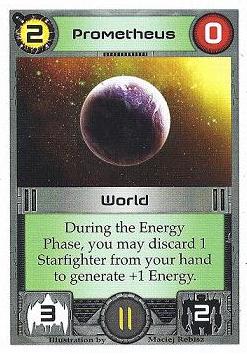
Players also get a certain amount of energy points, based upon the amounts shown on the planets that they control, certain cards that give bonus energy, and any energy tokens you might pick up along the way. Energy is used to purchase and deploy cards and goes hand in hand with actions. Pretty much every action that you take will cost you at least one energy, but plenty of actions will require quite a bit more.
A round consists of the players completing six phases of play. During a round the players will take turns using up all of their actions and energy until these are all depleted, at which point the players discard any remaining cards in their hand and play proceeds to the next round.
Most of the phases are housekeeping ones where you draw your cards (each player starts with six cards in their hand every round), populate the center zone with cards to draft, calculate your available energy and actions, and so on. All of the excitement takes place in the Action phase, when you get to use up those actions and energy to take over the galaxy.
During the action phase you can either:
Draft a card from the center zone: By paying the draft cost of the card with energy, plus a single action point. The card goes in your discard pile. You can only draft one card and then play passes to the next player.
Deploy Units: Some of the cards you will have are called unit cards. These are your troops and ships that you will use to invade the other worlds. You deploy them into your war zone in front of you. You can’t use them for invasion until they are deployed. You have to pay one action and the energy cost to deploy the unit listed on its card, but you can deploy as many as you can afford with energy and actions.
Invade a World: Use your deployed units to invade a world in the central zone. Each world has its own ground strength 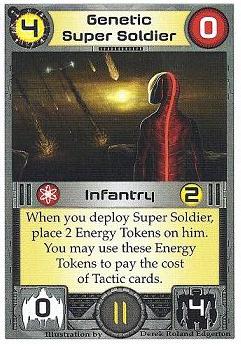
Use an ability: Some abilities on cards require you to use an action to activate them. You can choose to do this if you wish.
Once a player has performed one of the actions above, play proceeds to the next player. This continues until all of the players have used up their actions and energy and are unable to do anything else. Then play proceeds to the next round.
There are other card types in the game as well. Tactics cards can be played right from your hand and can perform many different functions. Prestige cards only come up in the last two rounds, and basically serve to give you bonus empire points at game end.
Once you have completed ten rounds, the game is over. You total up all of the empire points listed on all of your cards, along with any bonus points you have received. The player with the most points is the winner.
One more thing that I should mention, there is also a stack of cards that players can use for drafting purposes at the beginning of the game. These are optional cards, but they do add some individuality to your starting decks and provide some additional replayability value.
I liked Core Worlds a lot. It reminds me a bit of Race for the Galaxy, but a lot less complicated and less abrupt of an ending. All the players are in it until game end, and you know exactly when the game is going to end so you can plan your strategy as applicable.
At first I thought the game really didn’t have enough meat to it, but as I played and found myself trying to use different strategies and combos to win I realized that there is actually quite a bit there under the hood. There are lots of different abilities you can experiment with, and I did. I find myself looking forward to the expansion to Core Worlds already.
Set-up and end game sorting was the only pain I found while playing. This is typical of deck building games though, so really if you like DBG’s then this won’t bother you. Core Worlds is nicely thematic and a good sci-fi deck building game.
- A Dungeon Delve for Kids?: A Review of Dungeon! - Oct 24, 2022
- Better, Stronger, Faster | Descent: Journeys in the Dark Second Edition Reviewed - Oct 23, 2022
- Your Planet is Doomed!: Invasion from Outer Space Reviewed - Oct 22, 2022


